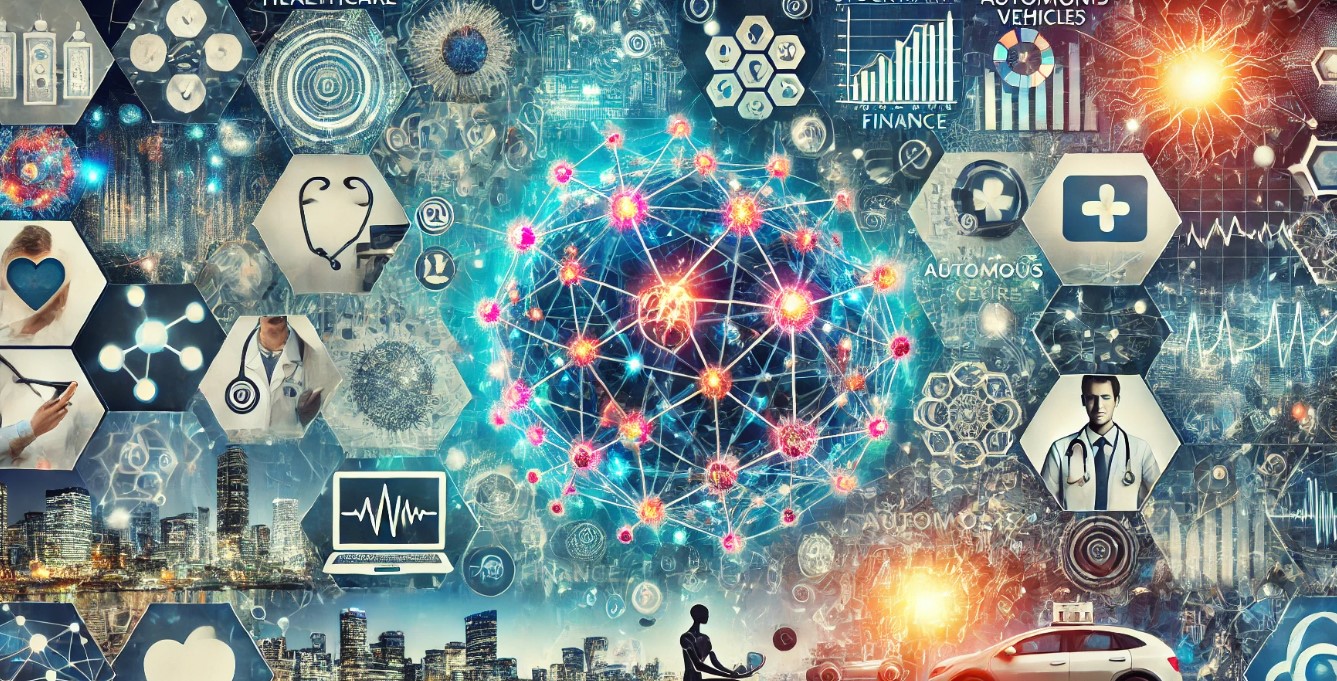Artificial Neural Networks (ANNs) have become a cornerstone of modern artificial intelligence (AI), driving advancements in machine learning, data analysis, and computational efficiency. Their development has ushered in a new era of computing, where machines can mimic human cognitive functions to solve complex problems and enhance decision-making processes.
- ANNs and Deep Learning: Artificial Neural Networks (ANNs) are modeled after the human brain and enable machines to learn and make predictions. Their advanced form, deep learning, processes large datasets and extracts complex patterns, driving innovations in fields like speech recognition, autonomous driving, and natural language processing.
- 2024 Nobel Prize Recognition: The Nobel Prize in Physics acknowledged researchers for improving neural network efficiency and broadening their applicability in healthcare, finance, and other industries.
- Applications Across Industries: ANNs are used to develop predictive models in healthcare, detect fraud in finance, and personalize entertainment experiences, showcasing their transformative potential.
- Challenges and Future Directions: ANNs face challenges such as high computational demands and the “black box” problem, but future advancements in algorithms, hardware, and ethical frameworks will help overcome these limitations and increase their societal impact.
At their core, artificial neural networks are inspired by the human brain’s structure and function. They consist of interconnected nodes, or “neurons,” which process and transmit information in a manner akin to biological neural networks. This architecture enables ANNs to learn from data, adapt to new information, and make predictions, making them invaluable tools in various applications.
One of the most significant breakthroughs in ANNs is their ability to perform deep learning. This advanced form of machine learning involves multiple layers of neural networks, allowing for the processing of vast amounts of data and the extraction of intricate patterns and features. Deep learning has been instrumental in achieving remarkable feats, such as image and speech recognition, natural language processing, and autonomous driving technologies.
The 2024 Nobel Prize in Physics recognized the contributions of researchers who have advanced our understanding and application of artificial neural networks. Their work has not only improved the efficiency of neural network algorithms but also expanded their applicability across different fields, from healthcare and finance to entertainment and transportation.
As reported by various sources, the laureates’ achievements highlight the transformative potential of ANNs in addressing real-world challenges. For instance, in healthcare, ANNs are being employed to develop predictive models for disease diagnosis and treatment planning, improving patient outcomes and reducing costs. In finance, they enhance fraud detection systems and optimize trading strategies, while in entertainment, they enable more personalized content recommendations.
Despite their impressive capabilities, artificial neural networks face certain limitations. They require substantial computational resources and large datasets for training, which can be a barrier for smaller organizations. Additionally, the “black box” nature of ANNs, where decision-making processes are not easily interpretable, raises concerns about transparency and accountability.
Looking forward, the future of artificial neural networks lies in overcoming these challenges and expanding their reach. Innovations in hardware, such as quantum computing, and advancements in algorithms are expected to enhance the efficiency and interpretability of ANNs. Moreover, ethical considerations and regulatory frameworks will play a crucial role in ensuring the responsible development and deployment of AI technologies.
In conclusion, artificial neural networks represent a pivotal advancement in computing, with the potential to revolutionize industries and improve the quality of life. As research progresses, their impact on society is poised to grow, offering exciting possibilities for innovation and problem-solving in the digital age.
What can a business use a artificial neural network for?
Businesses can use artificial neural networks (ANNs) for a wide range of applications across various industries, taking advantage of their ability to process large amounts of data, recognize patterns, and make predictions. Here are some common use cases where businesses benefit from ANNs:
1. Predictive Analytics
- Forecasting Demand: Businesses can use neural networks to analyze historical sales data, seasonal trends, and other variables to predict future demand for products or services. This is crucial for inventory management, supply chain optimization, and reducing operational costs.
- Financial Forecasting: Neural networks can predict market trends, stock prices, or currency fluctuations by analyzing financial data, helping businesses make more informed investment decisions.
2. Customer Segmentation and Personalization
- Customer Behavior Analysis: Neural networks can analyze customer data (such as purchase history, browsing patterns, and demographics) to segment customers into groups with similar behaviors. This allows for personalized marketing campaigns and targeted promotions, which improve customer engagement and retention.
- Recommendation Systems: ANNs power recommendation engines, like those used by streaming services and e-commerce platforms, by analyzing customer preferences and suggesting products or content based on past behavior.
3. Fraud Detection and Risk Management
- Credit Risk Assessment: Neural networks can evaluate credit applications by analyzing various factors, such as credit history, income, and spending patterns, to assess an applicant’s risk of defaulting. This helps businesses in the financial sector make more accurate lending decisions.
- Fraud Detection: Banks and e-commerce businesses use neural networks to detect fraudulent transactions in real-time by recognizing unusual patterns of activity and flagging potential fraud before it occurs.
4. Natural Language Processing (NLP)
- Sentiment Analysis: ANNs can process customer reviews, social media posts, and support tickets to understand the sentiment behind the text (positive, negative, or neutral). This helps businesses improve customer satisfaction, resolve issues quickly, and monitor brand reputation.
- Chatbots and Virtual Assistants: Neural networks enable chatbots and virtual assistants to understand and respond to customer queries. By using NLP techniques, these systems can automate customer service, handle routine inquiries, and improve the overall customer experience.
5. Image and Video Recognition
- Product Quality Control: In manufacturing, businesses use neural networks for image recognition to automatically detect defects in products during the production process. This reduces human error, improves efficiency, and ensures higher quality standards.
- Security and Surveillance: Neural networks can analyze security footage and recognize faces, objects, or suspicious behavior, helping businesses enhance security and monitor assets effectively.
6. Supply Chain Optimization
- Logistics and Route Planning: Neural networks can analyze vast amounts of data, such as traffic conditions, weather, and delivery schedules, to optimize shipping routes, reduce transportation costs, and improve delivery times.
- Warehouse Management: ANNs can predict inventory needs and streamline warehouse operations by analyzing purchasing trends, supplier lead times, and demand forecasts.
7. Healthcare and Diagnostics
- Medical Imaging Analysis: Healthcare businesses use neural networks to analyze medical images (such as X-rays, MRIs, or CT scans) to detect anomalies, such as tumors or fractures, more accurately and efficiently than traditional methods.
- Patient Diagnosis: Neural networks can analyze patient data, including medical history, symptoms, and lab results, to assist healthcare providers in diagnosing conditions and recommending personalized treatment plans.
8. Pricing Optimization
- Dynamic Pricing Models: E-commerce and hospitality businesses use neural networks to adjust prices dynamically based on factors like demand, competition, customer behavior, and market trends. This helps maximize revenue while staying competitive in the market.
9. Employee Performance and Human Resources
- Talent Acquisition and Retention: Neural networks can analyze employee performance data, job market trends, and candidate qualifications to help HR departments predict which candidates are the best fit for certain roles and which employees are at risk of leaving.
- Workforce Scheduling: ANNs help optimize employee shift scheduling by analyzing past performance, availability, and workload, ensuring that businesses run efficiently without overworking staff.
10. Product Development and Innovation
- Design Optimization: Neural networks can assist engineers and product designers in creating new products by running simulations, optimizing designs, and predicting how new products will perform under various conditions.
- Customer Feedback Analysis: By analyzing customer feedback data, neural networks help businesses identify areas for improvement and innovation, enabling them to refine products and services to meet market demands.





![A Big Lots store in [[Murphy, North Carolina]] 7 April 2023, 16:39:50](https://newnooz.com/news/wp-content/uploads/2024/12/Big_lots-NEW_NOOZ.jpg)